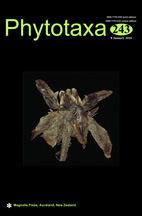Abstract
Amanita rufobrunnescens is described as a new species in the subgenus Lepidella section Amidella from Guangdong Province, China. It is characterized by whitish basidiomes that bruise reddish brown, brownish sub-membranous to fibrillose volval remnants on the pileus, a striate pileus margin, white lamellae with truncate lamellulae, grayish orange to light brown volva, amyloid basidiospores that are ellipsoid to elongate (9.5–)10–12(–13) × (5–)5.5–6.5(–7) µm, and 5–10 μm wide pileipellis hyphae with yellowish vacuolar pigments. There are no clamp connections. Molecular phylogenetic analyses based on the nuclear ribosomal large subunit of nuclear ribosomal DNA (LSU) and internal transcribed spacer (ITS) sequences reveal that A. rufobrunnescens is a distinct species.

